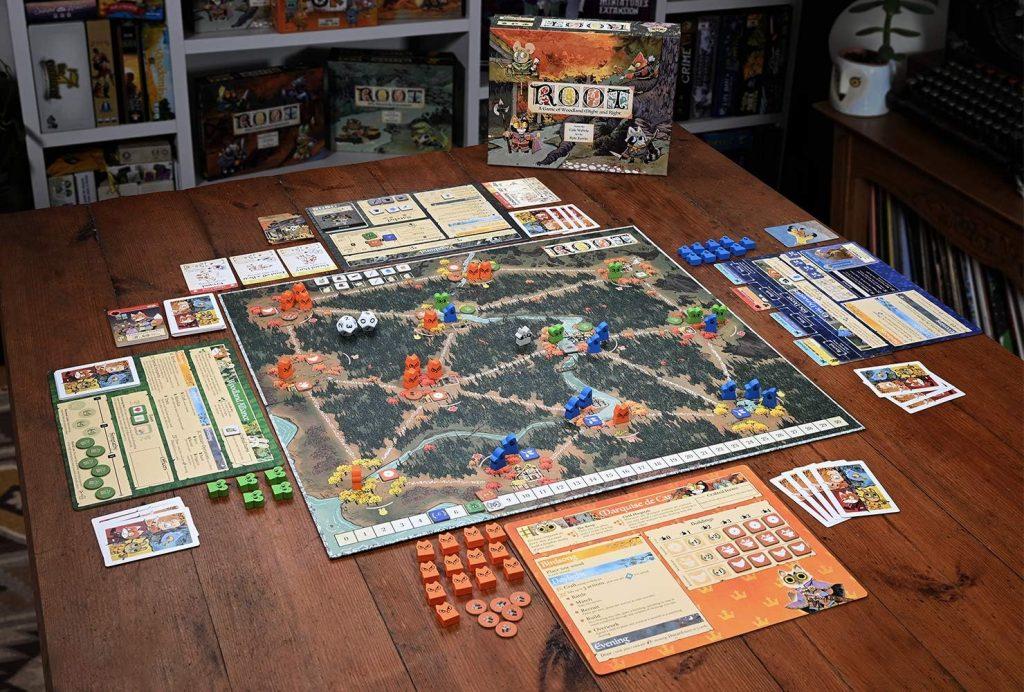ROOT – You’ve probably never played a board game like this before
Recently friends and I opened a brand new box game called Root. The rules and gameplay seemed complex at first, and it took us a while to truly understand what was required in order to play. But we perservered and ended up having a wonderful time and wishing we had more time for another round!
Root is a board game designed by Cole Wehrle and published by Leder Games. In Root, players take on the roles of various woodland factions vying for control of a vast forest kingdom. The game is known for its asymmetrical gameplay which is not like most games you’ve played before.
With asymmetrical gameplay each player has different capabilities, resources, roles, objectives, and strategies. This contrasts with symmetrical games, where all players generally start with the same conditions and abilities. Asymmetrical games can offer a rich, varied experience because each player might have to employ different tactics and strategies based on their unique position or role in the game. Root has garnered significant attention in the board gaming community for its depth, strategy, and innovative approach to asymmetrical gameplay.
So to start with Roots, players choose to be a faction. In the base game, there are only 4 factions to choose from:
- Marquise de Cat: They start with control over most of the board and aim to industrialize the forest by building structures and generating resources.
- Eyrie Dynasties: A once-dominant bird faction aiming to reclaim their lost kingdom. They have a decree system where they must expand and take actions in a specific order, or they risk falling into turmoil.
- Woodland Alliance: They represent the oppressed creatures of the woodland and seek to lead a revolt against the ruling factions. They gather supporters and orchestrate uprisings.
- Vagabond: A lone wanderer who can form alliances with other factions or choose to strike out on their own. The Vagabond can help or hinder other players in exchange for items or services.
The game has seen several expansions that introduce new factions and mechanics, further increasing its depth and replayability and allowing more than 4 players. It is recommended, however, that when you’re learning the game, keep to no more than 4 factions. Once you’ve played a round as a certain Faction, you may likely decide you want to play that Faction again now that you understand its strategies or you might decide to try a different Faction. And this is part of what makes Root such a great experience. Every game will be different for each player.
Expansions for More Players
- The Riverfolk Expansion: This expansion introduces two new factions – the Lizard Cult and the Riverfolk Company – and increases the maximum player count to six.
- The Underworld Expansion: Adds two more factions – the Corvid Conspiracy and the Underground Duchy. While this expansion doesn’t increase the player count beyond six, it offers even more variety and strategic options.
- Other Expansions: There are other expansions like “The Clockwork Expansion,” which provides automated versions of various factions, useful for solo play or filling out player counts in multiplayer games.
Simple Outline of Root Gameplay
Game Objective
The goal of “Root” is to earn victory points, and the first player to reach a certain number of points (usually 30) is declared the winner. Points can be earned in various ways depending on the faction you’re playing.
If it’s your first time playing, you can use the little booklets included with the base set. The booklets will advise you of play for each turn. When myself and friends played for the first time, we used this booklets almost half way through the game at which point we knew how to proceed and were able to put them down.
Setup
- Choose Factions: Each player selects a faction. In the base game, the choices are Marquise de Cat, Eyrie Dynasties, Woodland Alliance, and the Vagabond.
- Prepare the Board: Place the game board in the center of the table. The board depicts a forest with clearings connected by paths.
- Set Up Factions: Each faction sets up its pieces on the board according to its own setup rules. This usually involves placing warriors and buildings for factions like the Marquise de Cat and Eyrie Dynasties, or tokens for the Woodland Alliance. Each faction’s game board provides a detailed guide to both its setup and gameplay so no worries when you first start. These faction boards are tailored to the specific mechanics and strategies of each faction, offering players a handy reference throughout the game.
- Draw Cards: Players draw a starting hand of cards from the shared deck.
Game Play
The game is played in rounds, and each round consists of three phases for each player. This might seem frivolous at the beginning the the phases of a turn play an integral part in the game:
- Birdsong (Start of Turn): Certain factions perform specific actions during this phase, like adding cards to the Eyrie’s decree or spreading sympathy for the Woodland Alliance.
- Daylight (Main Actions): This is where most of the action happens. Players can spend actions to move pieces, battle, build, craft using cards, and more. The specific actions available and their costs vary between factions.
- Evening (End of Turn): Players draw cards and may have to discard down to a maximum hand size. Some factions also perform special actions during this phase.
Key Concepts
- Movement: Players can move their pieces (warriors, tokens, the Vagabond character) from one clearing to another along paths.
- Battle: Players can initiate battles in clearings where they have warriors. Battles are resolved using a dice-based combat system similar to Risk.
- Building and Crafting: Some factions build structures like sawmills, workshops, or roosts to gain resources or points. Crafting involves using cards to create items or score points.
- Cards: Cards are used for crafting and also have suit symbols that align with the clearings on the board. They play various roles depending on the faction.
Winning the Game
Players accumulate victory points by controlling clearings, winning battles, crafting items, completing quests (as the Vagabond), and through faction-specific objectives. How a player wins points varies from faction to faction. The first player to reach the required number of victory points (usually 30) wins the game.
About the artist
The game’s art, designed by Kyle Ferrin, gives Root a whimsical yet strategic look, capturing the woodland theme perfectly. Kyle Ferrin is known for his distinctive and engaging art style, especially in the board game community. His work has been featured in several games beyond Root, including Vast, Fort, Oath and Arcs. Ferrin’s art style is characterized by its vivid colours, whimsical characters, and a sort of charming, storybook quality that adds a unique depth and atmosphere to the games he works on. His artwork not only enhances the visual appeal of these games but also contributes significantly to the thematic storytelling and overall gaming experience.
About the game designer
Cole Wehrle is known for designing games that are rich in theme and strategy, often featuring unique and innovative mechanics. Wehrle’s games are often celebrated for their thematic depth, historical accuracy, and innovative gameplay. They tend to appeal to gamers who enjoy complex strategy, negotiation, and a rich narrative experience. Some of Wehrle’s other game designs and collaborations include: Pax Pamir, Oath: Chronicles of Empire and exile, John Company, An Infamous Traffic, and The King is Dead.
Deets
- 60 to 90 minutes for experienced players.
- Up to 120 minutes or more for players who are new to the game or when playing with a larger group.
- Ages 10 and Up
- Purchase on Amazon here (note, this may be an affiliate link supporting Gifts for Card Players)





